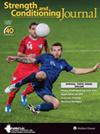Ready or Not, Here I Come: A Scoping Review of Methods Used to Assess Player Readiness Via Indicators of Neuromuscular Function in Football Code Athletes
IF 3
4区 医学
Q2 SPORT SCIENCES
引用次数: 6
Abstract
ABSTRACT A scoping review methodology was used to assess player readiness via indicators of neuromuscular function in response to training load. Literature search included PubMed, Web of Science, SportDiscus, and CINAHL. Search strategy was based on Population-Concept-Context framework evaluating football code athletes with the focus on player readiness in the context of longitudinal monitoring across quantified training loads with an emphasis on neuromuscular function. Demographics, frequency of data collection, methods of monitoring readiness, neuromuscular function, duration of monitoring period, and quantification of training loads were reported. Authors independently reviewed articles and, in the case of disagreement, a vote determined inclusion. The sports of rugby (n = 13) and soccer (n = 11) were most frequently examined, followed by Australian Rules Football (n = 6) and American Football (n = 1). The most common methods assessed systemic readiness with the primary focus on jump and sprint testing. Findings identified limited evidence supporting structural and tissue-specific monitoring tools. Player readiness assessment strategies have evolved with advances in technology and analytics. It is recommended that future research focus on a variety of populations, including youth and women athletes. This review is the first to summarize methods of assessing player readiness using indicators of neuromuscular function in football code athletes.准备好与否,我来了:通过足球规范运动员的神经肌肉功能指标评估球员准备情况的方法综述
摘要:采用范围审查方法,通过神经肌肉功能指标对训练负荷的反应来评估球员的准备情况。文献检索包括PubMed、Web of Science、SportDiscus和CINAHL。搜索策略基于人口概念上下文框架,评估足球代码运动员,重点是在量化训练负荷的纵向监测背景下的球员准备情况,重点是神经肌肉功能。报告了人口统计学、数据收集频率、监测准备状态的方法、神经肌肉功能、监测期的持续时间和训练负荷的量化。作者独立审查文章,如果意见不一致,则通过投票决定入选。橄榄球(n=13)和足球(n=11)是最常见的检查项目,其次是澳大利亚规则足球(n=6)和美式足球(n=1)。最常见的方法评估系统准备情况,主要关注跳跃和冲刺测试。研究结果表明,支持结构和组织特异性监测工具的证据有限。球员准备状态评估策略随着技术和分析的进步而发展。建议未来的研究重点关注各种人群,包括青年和女运动员。这篇综述首次总结了在足球规范运动员中使用神经肌肉功能指标评估球员准备状态的方法。
本文章由计算机程序翻译,如有差异,请以英文原文为准。
求助全文
约1分钟内获得全文
求助全文
来源期刊

Strength and Conditioning Journal
社会科学-运动科学
CiteScore
4.70
自引率
8.00%
发文量
49
审稿时长
6-12 weeks
期刊介绍:
Strength and Conditioning Journal is the professional journal for strength coaches, personal trainers, physical therapists, athletic trainers, and other health professionals working in the strength and conditioning field. The journal’s mission is to publish articles that report both the practical applications of research findings and the knowledge gained by experienced professionals.
 求助内容:
求助内容: 应助结果提醒方式:
应助结果提醒方式:


